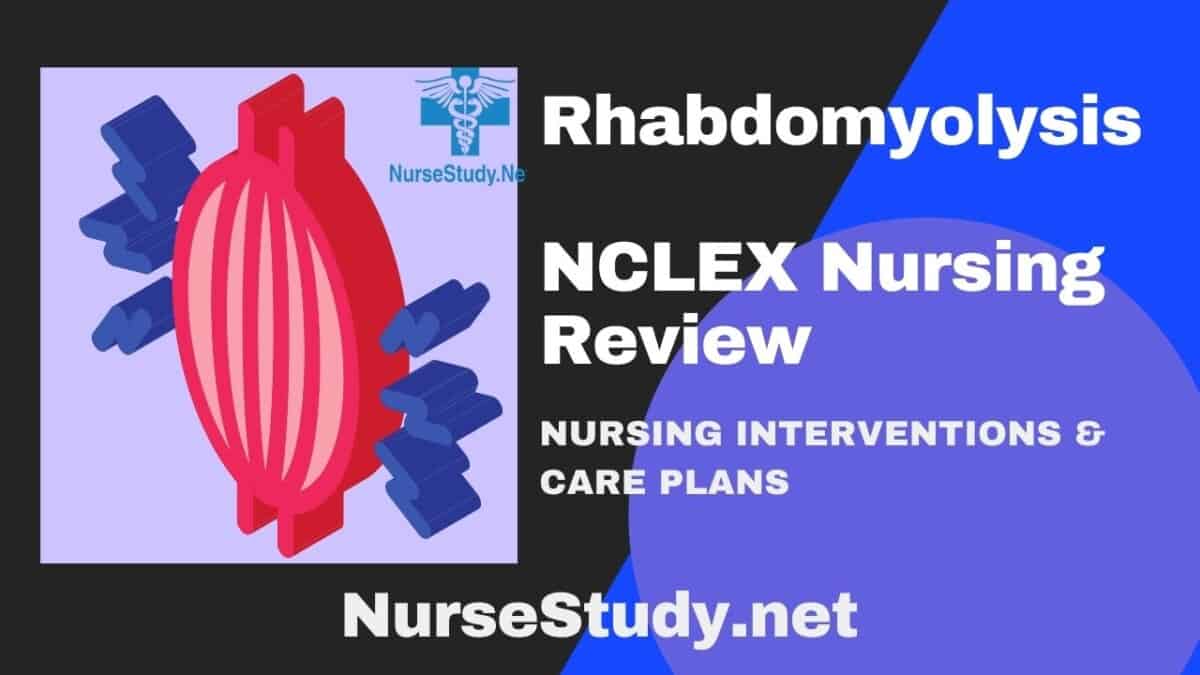Rhabdomyolysis is a serious medical condition characterized by rapid destruction of skeletal muscle tissue, leading to the release of muscle cell contents into the bloodstream. This comprehensive guide focuses on essential nursing diagnoses, interventions, and care plans for managing patients with rhabdomyolysis.
Understanding Rhabdomyolysis
Rhabdomyolysis occurs when damaged muscle tissue breaks down rapidly, releasing myoglobin, creatine kinase, and other cellular contents into the bloodstream. This muscle breakdown can overwhelm the kidneys and lead to acute kidney injury if not properly managed.
Common Causes
- Trauma or crush injuries
- Extreme physical exertion
- Medications and toxic substances
- Heat stroke and dehydration
- Prolonged immobilization
- Genetic muscle disorders
- Infections and inflammatory conditions
Clinical Manifestations
- Muscle pain and weakness
- Dark, tea-colored urine
- Decreased urine output
- Fatigue and weakness
- Fever
- Nausea and vomiting
- Confusion or altered mental status
Nursing Care Plans for Rhabdomyolysis
Nursing Care Plan 1. Risk for Acute Kidney Injury
Nursing Diagnosis Statement:
Risk for Acute Kidney Injury related to myoglobin-induced tubular damage and decreased renal perfusion
Related Factors:
- Elevated serum myoglobin levels
- Dehydration
- Metabolic acidosis
- Decreased renal blood flow
Nursing Interventions and Rationales:
Monitor fluid intake and output hourly
- Rationale: Ensures adequate hydration and kidney function
Assess urine characteristics every shift
- Rationale: Early detection of kidney dysfunction
Monitor serum electrolytes and creatinine levels
- Rationale: Identifies electrolyte imbalances and kidney function
Administer IV fluids as ordered
- Rationale: Maintains adequate renal perfusion
Desired Outcomes:
- Maintain urine output >30 mL/hour
- Demonstrate normal serum electrolyte levels
- Show improving BUN and creatinine levels
Nursing Care Plan 2. Acute Pain
Nursing Diagnosis Statement:
Acute Pain related to muscle tissue damage and inflammation
Related Factors:
- Muscle cell breakdown
- Inflammatory response
- Tissue edema
- Compartment syndrome
Nursing Interventions and Rationales:
Assess pain characteristics using a standardized scale
- Rationale: Establishes baseline and monitors progression
Position patient for comfort
- Rationale: Reduces muscle tension and promotes comfort
Administer prescribed pain medications
- Rationale: Manages pain while avoiding nephrotoxic agents
Apply cold/warm compresses as appropriate
- Rationale: Provides local pain relief
Desired Outcomes:
- Reports pain level ≤3 on a 0-10 scale
- Demonstrates improved mobility
- Uses effective pain management strategies
Nursing Care Plan 3. Impaired Physical Mobility
Nursing Diagnosis Statement:
Impaired Physical Mobility related to muscle weakness and pain
Related Factors:
- Muscle damage
- Pain
- Weakness
- Fear of movement
Nursing Interventions and Rationales:
Assess mobility status every shift
- Rationale: Monitors progression and identifies needs
Implement progressive mobility protocol
- Rationale: Prevents complications of immobility
Collaborate with physical therapy
- Rationale: Ensures appropriate exercise progression
Provide assistive devices as needed
- Rationale: Promotes safe mobility
Desired Outcomes:
- Demonstrates improved strength and mobility
- Participates in a prescribed exercise program
- Maintains skin integrity
Nursing Care Plan 4. Risk for Electrolyte Imbalance
Nursing Diagnosis Statement:
Risk for Electrolyte Imbalance related to cellular breakdown and kidney dysfunction
Related Factors:
- Release of intracellular contents
- Altered kidney function
- Fluid shifts
- Metabolic acidosis
Nursing Interventions and Rationales:
Monitor serum electrolytes every 4-6 hours
- Rationale: Early detection of imbalances
Assess for signs of hyperkalemia
- Rationale: Prevents life-threatening complications
Administer electrolyte replacement as ordered
- Rationale: Maintains normal electrolyte levels
Monitor cardiac rhythm
- Rationale: Detects electrolyte-induced arrhythmias
Desired Outcomes:
- Maintains normal serum electrolyte levels
- Shows no signs of cardiac complications
- Demonstrates normal fluid balance
Nursing Care Plan 5. Deficient Knowledge
Nursing Diagnosis Statement:
Deficient Knowledge related to lack of information about rhabdomyolysis management and prevention
Related Factors:
- Unfamiliarity with condition
- Complex treatment regimen
- Anxiety about diagnosis
- Language or cultural barriers
Nursing Interventions and Rationales:
Assess current knowledge level
- Rationale: Identifies learning needs
Provide education about the condition and prevention
- Rationale: Promotes self-management
Teach warning signs requiring medical attention
- Rationale: Ensures early intervention
Provide written materials
- Rationale: Reinforces verbal education
Desired Outcomes:
- Verbalizes understanding of the condition
- Demonstrates preventive measures
- Identifies warning signs requiring medical attention
References
- American Journal of Nursing (2023). “Rhabdomyolysis: Updated Guidelines for Nursing Care.” 123(4), 28-39.
- Baeza-Trinidad R. Rhabdomyolysis: A syndrome to be considered. Med Clin (Barc). 2022 Mar 25;158(6):277-283. English, Spanish. doi: 10.1016/j.medcli.2021.09.025. Epub 2021 Dec 3. PMID: 34872769.
- Cabral BMI, Edding SN, Portocarrero JP, Lerma EV. Rhabdomyolysis. Dis Mon. 2020 Aug;66(8):101015. doi: 10.1016/j.disamonth.2020.101015. Epub 2020 Jun 10. PMID: 32532456.
- Journal of Emergency Nursing (2024). “Early Recognition and Management of Rhabdomyolysis: A Nursing Perspective.” 50(1), 15-27.
- Kuloglu E. Rhabdomyolysis presenting with septic shock in a 21 year old female patient: A case report. J Pak Med Assoc. 2024 Sep;74(9):1695-1698. doi: 10.47391/JPMA.10501. PMID: 39279081.
